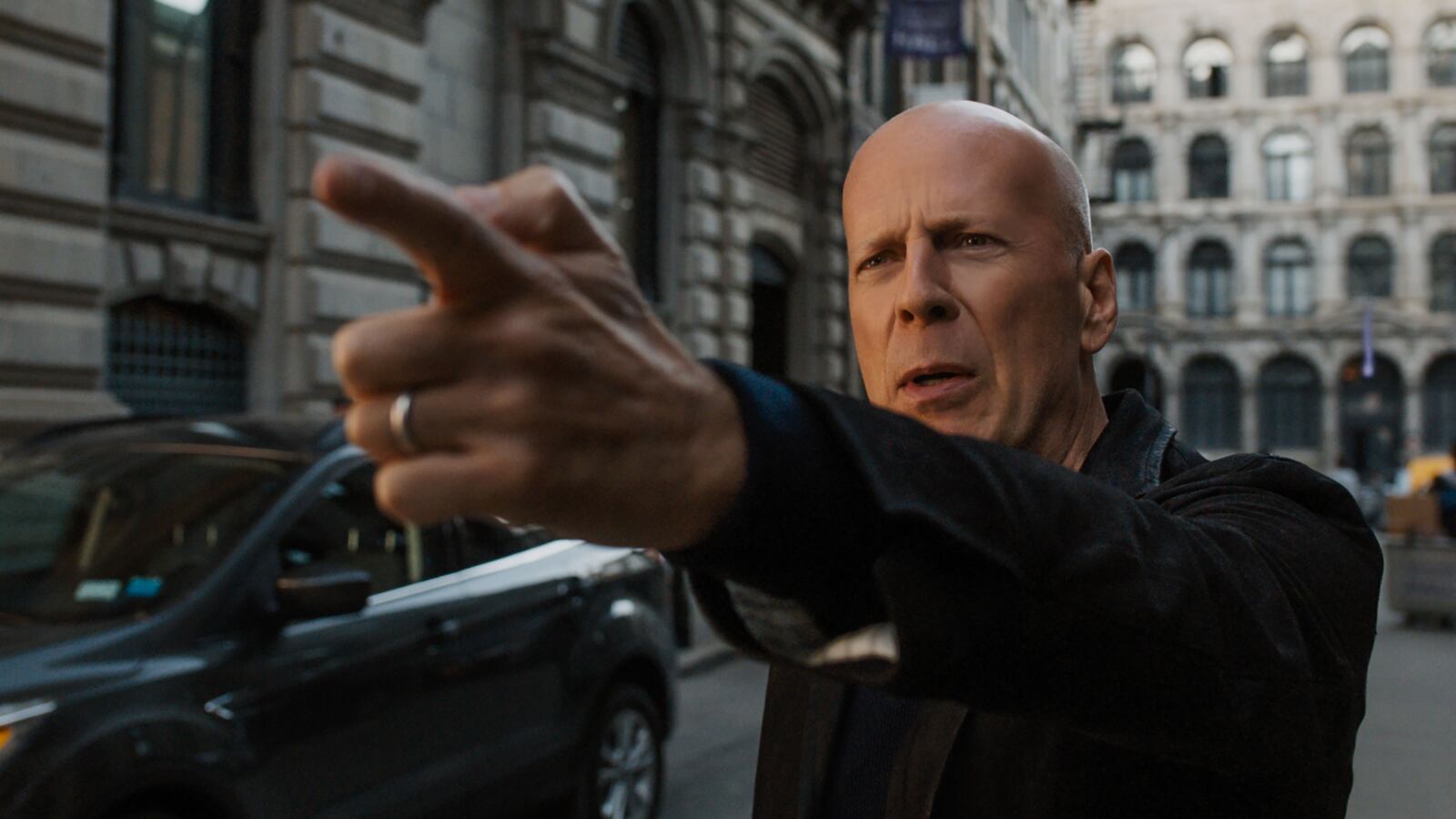Death Wish stars Bruce Willis as Dr. Paul Kersey, an ER physician who’s directly affected by Chicago’s rampant crime when, on the night of his birthday, his wife Lucy (Elizabeth Shue) is murdered and his daughter Jordan (Camilla Morrone) is left in a coma by a trio of robbers. Frustrated by the police’s inability to catch these “animals,” Kersey takes matters into his own hands—which, in this instance, means he starts hunting down and murdering lawbreakers with his trusty handgun.
He’s an alt-right wet dream: a modern-day gunslinger (played by one of the industry’s most notable conservatives) who uses his sidearm to right wrongs and protect the innocent—a fantasy that, in the wake of the October 2016 Las Vegas shooting (which prompted the film to delay its initial October release), as well as last month’s massacre in Parkland, Florida, is about as ill-timed as they come.
Directed by Hostel’s Eli Roth, here channeling his horror-movie impulses for grisly street-warfare mayhem, Death Wish is a remake of 1974’s Charles Bronson hit, which itself was adapted from Brian Garfield’s novel, and which spawned four sequels—each one of them more ridiculous and distasteful than the last. It follows its predecessor’s template to a tee, stacking the narrative deck so that its villains are unquestionable monsters who deserve hell, and its police officers are incompetent and/or stymied by bureaucratic obstacles—a situation that thus imbues Kersey with a moral righteousness that justifies his vigilante behavior. He’s judge, jury and executioner—a Breitbart-esque Batman—because somebody’s got to do it!
Such material is, at its core, fascistic—and always was. Of the five prior Death Wishes, Michael Winner’s 1974 original remains the best, if only because it pays passing lip service to the moral struggle of its main character (although it still completely negates author Garfield’s pessimistic view of vigilantism). A New York City architect who served in Korea as a conscientious objector, Bronson’s Kersey is transformed from an avowed liberal into an assassin when his wife is slain by creeps (including a young Jeff Goldblum!) and his daughter is beaten so badly that she winds up a veritable zombie.
The grieving Kersey initially, and understandably, wants revenge against those who’ve destroyed his life. Yet the rejuvenating thrill he gets from his first kill soon sends him on routine nighttime strolls through Central Park, looking for any would-be mugger to murder. Evading the cops (here, Vincent Gardenia’s Lt. Frank Ochoa), and hiding his homicidal conduct from his son-in-law and coworkers, Kersey is forwarded as the cartoon answer to the question of how to clean up crime-ridden 1970s New York.
The thing is, this “good guy with a gun” is also, you know, a serial killer.
Kersey’s exploits only grew more devious and deranged in 1982’s Death Wish II, which relocated him to Los Angeles, and had him dealing with punks (including a young Laurence Fishburne!) who killed his daughter and housekeeper—all while lying about his past and present escapades to his new girlfriend (Bronson’s real-life wife Jill Ireland). As would be the case in all the sequels, the fact that Kersey has again found himself in this situation is wholly absurd. And that absurdity, in turn, underlines—along with Kersey’s ever-more-robotic sadism—that the films are less about investigating vengefulness than about promoting a bloodthirsty vision of a virile man (with a giant phallic weapon) doing what an impotent system can’t—or won’t.
Given its fixation on brutally macho do-gooder-ism, the Death Wish saga (produced, in its final three installments, by infamous The Cannon Group schlockmeister Menahem Golan) naturally pivots around the abuse and murder of women. Moreover, from the first film’s scenes of Kersey watching O.K. Corral-style performances in Arizona, to Death Wish 3’s entire plot—in which Kersey, avenging his war buddy’s death, becomes the outsider returning to protect an apartment-complex community from a menacing gang (including Bill & Ted’s Alex Winter!), and then rides off into the sunset—to the formulaic cowboy crap peddled by Death Wish IV: The Crackdown and Death Wish V: The Face of Death, the franchise casts its action as an urban Western. The problem being: Bronson’s Kersey, employing a gigantic .475 Wildey Magnum and missile launcher in Death Wish 3 (all with the blessing of the NYPD!), and shoving Michael Parks’ baddie into a vat of acid in Death Wish V, is more holier-than-thou sadistic than any gunslinger ever played by John Wayne or Clint Eastwood.
Though the Death Wish films are brimming with unintentional comedy (see, for example, Ed Lauter’s Death Wish 3 police lieutenant Shriker constantly calling Bronson “dude”), they’re ultimately reactionary works that reflect the social anxieties of their given eras: muggers and rapists in the 1970s; gangs and drug-dealers in the 1980s; white-collar criminals in the 1990s. Roth’s new Death Wish follows in its forefathers’ footsteps, turning Willis’ Kersey into a gun-toting white guy solution to the Chicago gun crime problem. If that R-rated “comic book” setup isn’t incendiary enough, the filmmaker then has Kersey stalk the streets in a hoodie, thereby appropriating one of the symbols of the Black Lives Matter movement (courtesy of the Trayvon Martin case). Pushing buttons doesn’t get much crasser—or more inapt, given the current cultural climate.
The sight of Willis’ Kersey shopping for firearms at a local sporting goods store (not Dick’s!) provides the requisite gun porn, and his eventual use of a Glock stolen from a dying patient underscores the film’s topsy-turvy desire to have us root for a killer carrying out a personal vendetta with an illegally-obtained weapon. There’s some gnarly gore (per Roth tradition), and some police complicity in this rampage, and a lot of other tone-deaf nonsense.
I know, I know, the film isn’t a policy statement or piece of legislation, it’s an ultra-violent action movie about a man wiping out inarguably scummy adversaries—and admittedly, I often love those (John Wick: Chapter 2, for example), at least when they operate in a make-believe reality. Yet Death Wish’s gleeful celebration of DIY justice takes place in our very specific here and now, and is predicated on the idea that the aggrieved are well within their rights to start firing away in cities like bloodthirsty superheroes—a notion that doesn’t ring true in the aftermath of endless mass shootings perpetrated by angry loners.
No amount of stylish glossiness can mask Death Wish’s underlying rot. And in fact, Roth doesn’t even try; on the contrary, he exploits his star’s action-hero persona to further get audiences on Kersey’s side.
In an early sequence, Roth uses split-screens to simultaneously depict Kersey tending to patients and training with his new gun, all set to AC/DC’s “Back in Black.” Hey, hey, hey, hey, the message is clear: forget the soft-and-cuddly sissy who wouldn’t knock out a bully in the film’s first few scenes, now the real Bruce Willis, he of Die Hard and Armageddon and The Fifth Element, is back! Even amidst so much unpleasantness, there’s no scene fouler than this, because it exposes the ugly symbiotic relationship between Hollywood fantasy and violent real-world mindsets.
As in the Bronson series, the new Death Wish is devoid of nuance, feigning “debate” (via talk radio sound bites) while depicting everything in figurative, and often literal, black and white terms. In 2018 even more than in 1974, this paean to triumphant vigilantism is, ultimately, a sham, because Kersey’s actions are essentially futile. Sure, there’s a happy ending tacked onto Willis’ saga, but its tease of a potential sequel suggests that this 21st-century Kersey has the same destiny as Bronson’s ancestor. The more “bad guys” he kills, the more he destroys his humanity, and the more he’ll keep on losing everyone he holds dear, until finally, Kersey—a loving, compassionate family man who’s remade himself into a compulsive killing machine—is left with no one, and nothing, except his destructive gun.
Some hero. And some solution.






